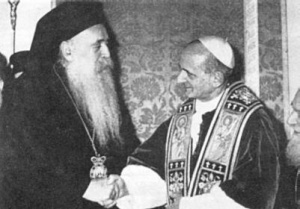Difference between revisions of "Athenagoras I (Spyrou) of Constantinople"
m |
m (→Early Life) |
||
| Line 5: | Line 5: | ||
==Early Life== | ==Early Life== | ||
| − | [[Patriarch]] Athenagoras was born Aristokles Spyrou in Vasilikón, near Ioánnina, Epirus, Greece, on [[March 25]], 1886. The son of the village doctor, his mother died when he was only 13. He attended the [[Theological School of Halki|Patriarchical Theological School]], graduating in 1910. Upon graduating he was [[ordination|ordained]] to the [[diaconate]] taking the name Athenagoras. He served as [[archdeacon]] of the [[Diocese of Pelagonia]] before becoming the secretary to [[Meletius IV (Metaxakis) of Constantinople|Archbishop Meletius]] of Athens in 1919. He was raised to the [[episcopate]] as the [[Metropolitan of Corfu]] in 1922. | + | [[Patriarch]] Athenagoras was born Aristokles Spyrou in Vasilikón, near Ioánnina, Epirus, Greece, on [[March 25]], 1886. The son of the village doctor, his mother died when he was only 13. He attended the [[Theological School of Halki|Patriarchical Theological School]], graduating in 1910. Upon graduating he was [[tonsured]] a [[monk]] and [[ordination|ordained]] to the [[diaconate]], taking the name Athenagoras. He served as [[archdeacon]] of the [[Diocese of Pelagonia]] before becoming the secretary to [[Meletius IV (Metaxakis) of Constantinople|Archbishop Meletius]] of Athens in 1919. He was raised to the [[episcopate]] as the [[Metropolitan of Corfu]] in December 1922, while still a deacon. |
==Archbishop of America== | ==Archbishop of America== | ||
Revision as of 17:24, September 12, 2006
Patriarch Athenagoras I (March 25, 1886–July 7, 1972) was the 268th Patriarch of Constantinople from 1948 to 1972.
Early Life
Patriarch Athenagoras was born Aristokles Spyrou in Vasilikón, near Ioánnina, Epirus, Greece, on March 25, 1886. The son of the village doctor, his mother died when he was only 13. He attended the Patriarchical Theological School, graduating in 1910. Upon graduating he was tonsured a monk and ordained to the diaconate, taking the name Athenagoras. He served as archdeacon of the Diocese of Pelagonia before becoming the secretary to Archbishop Meletius of Athens in 1919. He was raised to the episcopate as the Metropolitan of Corfu in December 1922, while still a deacon.
Archbishop of America
In 1930, Metropolitan Damaskinos, after returning from a trip to the Greek Orthodox Archdiocese of America, recommened to Patriarch Photios II that Athenagoras be appointed Archbishop of America. Damaskinos felt that Athenagoras was best suited to fix the many problems of the archdiocese, and Photios made the appointment on August 30, 1930.
When he assumed his new position on February 24, 1931, Athenagoras was faced with the task of bringing unity and harmony to a diocese that was racked with dissension between Royalists and Venizelists who had virtually divided the country into independent dioceses. To correct this he centralized the eccelesiastical administration in the Archdiocesean offices with all other bishops serving as auxiliaries, appointed to assist the archbishop, without dioceses and administrative rights of their own. He actively worked with his communities to facilitate these reforms. He expanded the work of the clergy-laity congresses and founded the Holy Cross School of Theology. His capable leadership allowed him to withstand the early opposition he faced and eventually gain the love and devotion of his flock.
Patriarchate
On November 1, 1948, Athenagoras was elected Patriarch of Constantinople, and was flown to Istanbul in the personal airplane of then-president Harry Truman. As patriarch, he was actively involved with the World Council of Churches and improving relations with the Pope. His long reign ended with his died in Istanbul on July 7, 1972.
His 1964 meeting with Pope Paul VI in Jerusalem led to the mutual lifting of the Bulls of Excommunication that resulted in the Great Schism of 1054. This was a significant step towards restoring communion between Rome and Constantinople. It produced the Catholic-Orthodox Joint Declaration of 1965, which was publicly read on December 7, 1965, simultaneously at a public meeting of the Second Vatican Council in Rome and at a special ceremony in Istanbul. The declaration did not end the schism, but showed a desire for greater reconciliation between the two churches. Nevertheless, not all Orthodox shared this sentiment, resulting in one hierarch, Metropolitan Philaret, writing a response to the patriarch that same year.
| Athenagoras I (Spyrou) of Constantinople | ||
|---|---|---|
| Preceded by: Alexander (Demoglou) |
Archbishop of America 1931-1948 |
Succeeded by: Michael (Konstantinides) |
| Preceded by: Maximus V |
Patriarch of Constantinople 1948-1972 |
Succeeded by: Demetrios I |
External links
- St. Paul's Greek Church
- Catholic-Orthodox Joint declaration of 1965
- A Protest to Patriarch Athenagoras On the Lifting of the Anathemas of 1054 by Metr. Philaret of New York (December 2/15, 1965)
- Another Common Declaration of Pope Paul VI and the Ecumenical Patriarch Athenagoras I dated 28 October 1967
- Remembering Patriarch Athenagoras
- "Patriarch Athenagoras: Prophet of Love" by Bishop John (Kallos) of Thermon (Orthodox Research Institute)
Categories > Organizations > Educational Institutions
Categories > Organizations > Seminaries > Theological School of Halki Graduates
Categories > People
Categories > People > Clergy > Bishops
Categories > People > Clergy > Bishops
Categories > People > Clergy > Bishops > Bishops by century > 20th-century bishops
Categories > People > Clergy > Bishops > Bishops by city > Bishops of Corfu
Categories > People > Clergy > Bishops > Bishops by city > Patriarchs of Constantinople
